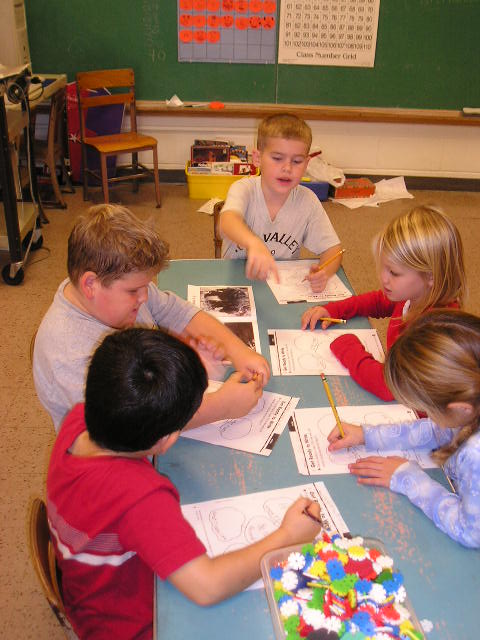

Amy Stewart
Title: Get Ready to Write
Grade Level: 1
Materials: Scholastic Readers Time to Discover Books: Foxes, Bears, Squirrels, Penguins, pencils, and web sheet
Purpose: Students work cooperatively to read the book and cooperatively complete the story web. Then students each take a piece of the web to orally report one part of the book.
Objectives:
Procedure:
1) Teacher reads a similar story to the whole class. As a group, students discuss the subject of the book, where it lives, what it eats, what it looks like, and another fact.
2) Students are separated into groups. At least one strong reader is put in each group. They are called the group leader and are told that everyone is to listen to the leader’s direction: make sure everyone has filled out each part before moving on, etc.
3) Explain the story web. The parts of the web to be filled out are “where it lives,” “what it eats,” “animal names,” what it looks like,” and “another fact.” Students are instructed to draw a picture for “what it looks like” and write words for the other parts. Questions answered.
4) Students break into groups to fill out web. Teacher circulates to help.
5) Students are reminded to take one part of the web to make a sentence to tell the class about their book. Students practice.
6) When ready, each group gives an oral report of their book to the class.
Closure: As students give their reports, students are able to give positive comments or ask questions to the group. Then, as a whole group, we discuss that what we have been doing is researching (finding out more about something) and reporting (summarizing and giving information to others). Discuss that reports can be done orally or that we could have done a report by writing those sentences down and adding pictures.
Rationale/How
it fits with the Curriculum
I chose to do this activity because as students are beginning to read, we question whether or not they are retaining any of the information, or just reading each word. It is common for them to concentrate on each word and miss the meaning. This is an activity to help students to practice reading to gain valuable information, and summarizing skills. It is also good practice for writing, sentence making, and presenting information.
This cooperative learning activity is a new type of learning for these first-graders. They have seen web making modeled by teachers, but have not completed one in this fashion. It is important to remember that students may need help with just learning how the process works. This activity is a great way to address students' diversity. Groups were strategically planned so that there was a really good reader in each group. In some of the groups, the leader did most of the reading. In other groups, the responsibility was shared. Everyone could take what they learned and help to answer questions. I also saw many students using pictures for clues. Then, the students helped each other write as well and made sure everyone had answers before moving on. This lesson proved to me that trying new teaching styles is exciting and challenging. The students handled the challenge very well. I can now see how giving students a challenge can mean that they rise to the challenge and broaden their learning experience. I am glad I tried this early on in student teaching.
Assessment:
I assessed students by whether or not they were participating in the group activity. I had one girl who was upset that she was not the leader of her group. I spoke individually with this girl about her need to participate to complete her web, and she did. Everyone seemed to find this activity very interesting, and was following the instructions, such as not moving on until everyone had finished each part. And, I also assessed the activity by the webs. I did not ask for full sentences. I just wanted the crucial information written in each area. I felt that everyone found appropriate information for each part. Then, through oral presentation, they put ideas into sentences, with only a minimal amount of difficulty.
Along with a reading opportunity and a chance to develop skills of collaboration, this was also an introduction to report writing. The next time I do this activity, I will have them write the sentences out and draw pictures to correspond with the writing, instead of oral reports. The attached work is an example of a story web. He did an excellent job of finding appropriate answers to the different web parts. For further growth, I would suggest to him that in the “another fact” category, he write a complete sentence to make his idea easier to understand. Otherwise, I was very happy with what I read.

